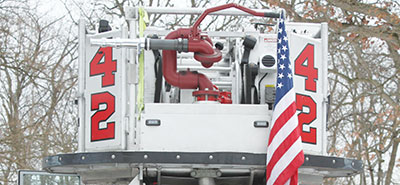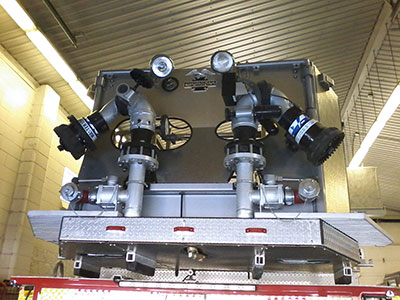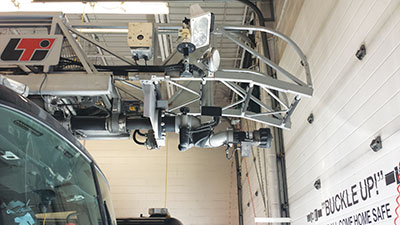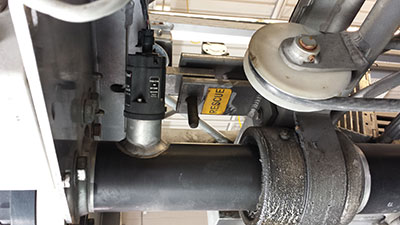
Features
Training
Back to Basics: May 2014
One function of a truck company is to supply elevated master streams.
April 24, 2014
By Mark van der Feyst
One function of a truck company is to supply elevated master streams. An aerial apparatus or ladder truck has an aerial device of some sort with either a single nozzle or multiple nozzles attached to the tip of the aerial for water delivery. There are times when fire crews need to deploy large volumes of water from a higher elevation to suppress and extinguish a fire, either as a defensive tactic or to protect exposures.
Most aerial apparatuses built in the last 20 years have pre-plumbed waterways that run underneath the length of the aerial ladder. However, not all aerials have on-board water pumps; those that don’t require an engine or pumper to supply the water pressure required for the nozzle(s) to flow adequately. If this is the case, make sure the supply hose is connected to the correct intake. The intake for the aerial master stream is usually located on the back of rear-mount ladder trucks or on the side of mid-mount ladder trucks. The intake is labeled accordingly.
 |
|
| Photo 1: A single smooth-bore nozzle, located on the back of the platform, can be a valuable tool for the truck company, especially when trying to protect exposures or apply large volumes of water at a fire scene. |
|
 |
|
| Photo 2: Alternately, some aerial or ladder trucks have two combination nozzles, located on either side of the platform. | |
 |
|
| Photo 3: If the aerial device is a straight ladder, there will be a single nozzle, located in the middle of the ladder. Both a combination nozzle and a smooth-bore nozzle would be useful on the fire ground; fire departments can decide which best services their needs. | |
 |
|
| Photo 4: Pinnable waterways use a pin to switch the device from rescue to water-flow modes. However, these pins have been known to fall out so extra caution must be paid when using a pinnable waterway on scene. Photos by Mark van der Feyst |
Some aerials have a single nozzle; others have double nozzles. The choice to have a smooth-bore nozzle or a combination nozzle depends on the fire department’s perception of the best way to deliver water. Photo 1 shows a single smooth-bore nozzle located in the middle of the platform while in photo 2, two combination nozzles are located on either side of the platform. If the aerial device is a straight ladder (see photo 3), there will be only a single nozzle located in the middle of the ladder.
Nozzles are either manual or automatic (photo 2 depicts both types). Manual nozzles must be operated by a firefighter on the platform. Automatic nozzles can be run at the pump panel or by remote at the turntable base.
Some straight aerial ladders have pinnable waterways; this option allows the ladder to be in rescue mode or a water-flowing mode. The pin can be removed and inserted into one of two holes that are marked rescue or water-flowing. Some ladders have a switch device or latch, instead of a pin, that can be rotated into the rescue or water-flow position. Labels on the top and bottom of the ladder identify the mode in which the aerial ladder is set (see photo 4).
A pinnable waterway is more streamlined than a pre-plumbed waterway and therefore enables the ladder tip to be placed closer to a window or rooftop for rescue.
While there are advantages to pinnable waterways, there are also safety concerns – primarily with the pin placement. On April 8, 2008, a deputy fire chief was killed in the line of duty in Erie, Penn., after he was struck by the aerial ladder’s water monitor and attached 30-foot aluminum pipe while fighting an industrial fire. The water monitor was launched from the elevated aerial ladder, which was equipped with a pinnable waterway, when it was charged with water. The National Institute for Occupational Safety and Health (NIOSH) investigation revealed that the pin did not always properly fit the holes; in this case, the pin was found on the ground in front of the ladder truck.
The NIOSH investigation also discovered 10 similar incidents involving waterways being launched off of aerial devices. There were no fatal injuries associated with the 10 incidents, and alternate designs, such as the switch or latch, have been introduced since 2008. If there is a pinnable waterway on your aerial device, it is vitally important that the pin or latch be checked before water begins to flow; this can be done during the truck check but also needs to be done on scene when using the aerial for master stream or rescue operations.
Mark van der Feyst is a 15-year veteran of the fire service. He works for the Woodstock Fire Department in Woodstock, Ontario. Mark instructs in Canada, the United States and India and is a local-level suppression instructor for the Pennsylvania State Fire Academy and an instructor for the Justice Institute of B.C. E-mail Mark at Mark@FireStarTraining.com
Print this page